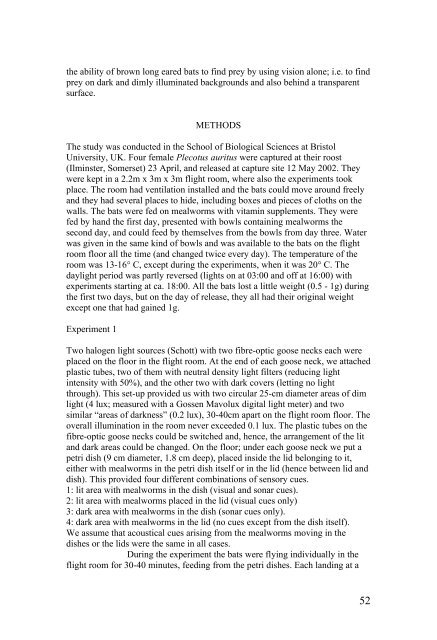Vision in echolocating bats - Fladdermus.net
Vision in echolocating bats - Fladdermus.net
Vision in echolocating bats - Fladdermus.net
Create successful ePaper yourself
Turn your PDF publications into a flip-book with our unique Google optimized e-Paper software.
the ability of brown long eared <strong>bats</strong> to f<strong>in</strong>d prey by us<strong>in</strong>g vision alone; i.e. to f<strong>in</strong>d<br />
prey on dark and dimly illum<strong>in</strong>ated backgrounds and also beh<strong>in</strong>d a transparent<br />
surface.<br />
METHODS<br />
The study was conducted <strong>in</strong> the School of Biological Sciences at Bristol<br />
University, UK. Four female Plecotus auritus were captured at their roost<br />
(Ilm<strong>in</strong>ster, Somerset) 23 April, and released at capture site 12 May 2002. They<br />
were kept <strong>in</strong> a 2.2m x 3m x 3m flight room, where also the experiments took<br />
place. The room had ventilation <strong>in</strong>stalled and the <strong>bats</strong> could move around freely<br />
and they had several places to hide, <strong>in</strong>clud<strong>in</strong>g boxes and pieces of cloths on the<br />
walls. The <strong>bats</strong> were fed on mealworms with vitam<strong>in</strong> supplements. They were<br />
fed by hand the first day, presented with bowls conta<strong>in</strong><strong>in</strong>g mealworms the<br />
second day, and could feed by themselves from the bowls from day three. Water<br />
was given <strong>in</strong> the same k<strong>in</strong>d of bowls and was available to the <strong>bats</strong> on the flight<br />
room floor all the time (and changed twice every day). The temperature of the<br />
room was 13-16° C, except dur<strong>in</strong>g the experiments, when it was 20° C. The<br />
daylight period was partly reversed (lights on at 03:00 and off at 16:00) with<br />
experiments start<strong>in</strong>g at ca. 18:00. All the <strong>bats</strong> lost a little weight (0.5 - 1g) dur<strong>in</strong>g<br />
the first two days, but on the day of release, they all had their orig<strong>in</strong>al weight<br />
except one that had ga<strong>in</strong>ed 1g.<br />
Experiment 1<br />
Two halogen light sources (Schott) with two fibre-optic goose necks each were<br />
placed on the floor <strong>in</strong> the flight room. At the end of each goose neck, we attached<br />
plastic tubes, two of them with neutral density light filters (reduc<strong>in</strong>g light<br />
<strong>in</strong>tensity with 50%), and the other two with dark covers (lett<strong>in</strong>g no light<br />
through). This set-up provided us with two circular 25-cm diameter areas of dim<br />
light (4 lux; measured with a Gossen Mavolux digital light meter) and two<br />
similar “areas of darkness” (0.2 lux), 30-40cm apart on the flight room floor. The<br />
overall illum<strong>in</strong>ation <strong>in</strong> the room never exceeded 0.1 lux. The plastic tubes on the<br />
fibre-optic goose necks could be switched and, hence, the arrangement of the lit<br />
and dark areas could be changed. On the floor; under each goose neck we put a<br />
petri dish (9 cm diameter, 1.8 cm deep), placed <strong>in</strong>side the lid belong<strong>in</strong>g to it,<br />
either with mealworms <strong>in</strong> the petri dish itself or <strong>in</strong> the lid (hence between lid and<br />
dish). This provided four different comb<strong>in</strong>ations of sensory cues.<br />
1: lit area with mealworms <strong>in</strong> the dish (visual and sonar cues).<br />
2: lit area with mealworms placed <strong>in</strong> the lid (visual cues only)<br />
3: dark area with mealworms <strong>in</strong> the dish (sonar cues only).<br />
4: dark area with mealworms <strong>in</strong> the lid (no cues except from the dish itself).<br />
We assume that acoustical cues aris<strong>in</strong>g from the mealworms mov<strong>in</strong>g <strong>in</strong> the<br />
dishes or the lids were the same <strong>in</strong> all cases.<br />
Dur<strong>in</strong>g the experiment the <strong>bats</strong> were fly<strong>in</strong>g <strong>in</strong>dividually <strong>in</strong> the<br />
flight room for 30-40 m<strong>in</strong>utes, feed<strong>in</strong>g from the petri dishes. Each land<strong>in</strong>g at a<br />
52


